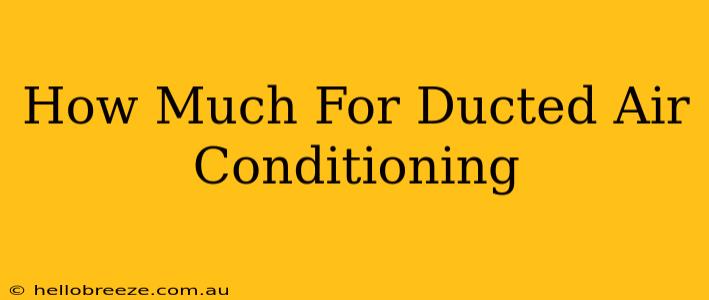Thinking about installing ducted air conditioning? It's a significant investment, offering whole-home climate control, but the cost can vary wildly. This guide breaks down the factors influencing the price of ducted air conditioning, helping you budget effectively.
Understanding the Cost Variables
The price of a ducted air conditioning system isn't fixed. Several key factors influence the final figure:
1. System Size and Capacity
This is arguably the biggest factor. Larger homes require more powerful systems with more extensive ductwork, significantly increasing the cost. The capacity, measured in kilowatts (kW), reflects the system's cooling power. A larger home or one with poor insulation will need a higher kW system, thus adding to the expense. Consider getting a professional assessment to determine the correct size for your home.
2. Type of System
Several types of ducted systems exist, each with a different price point:
- Reverse Cycle: These systems offer both heating and cooling, usually commanding a higher upfront cost but potentially saving money in the long run.
- Single-Zone vs. Multi-Zone: Multi-zone systems allow for independent temperature control in different areas of your home, increasing convenience and potentially energy efficiency, but also the price.
3. Brand and Features
Different brands offer varying levels of quality, efficiency, and features. Higher-end brands often come with a premium price tag but may offer better energy efficiency and longer warranties, offsetting the initial cost over time. Features like smart home integration, advanced filters, and quiet operation can also impact the overall cost.
4. Installation Complexity
The complexity of the installation significantly impacts the final price. Factors such as:
- Existing ductwork: Reusing existing ductwork can lower costs, while new ductwork installation adds a considerable expense.
- Home accessibility: Difficult-to-reach areas or complex house layouts can increase labor costs.
- Insulation requirements: Proper insulation is crucial for efficiency. If your home lacks adequate insulation, the cost will rise to address this.
5. Location and Labor Costs
Labor costs vary by location. Metropolitan areas generally have higher labor rates than regional areas. The installer's experience and reputation also influence pricing. Obtain multiple quotes to compare labor costs.
Getting Accurate Cost Estimates
To get a realistic estimate:
- Contact multiple reputable installers: Avoid choosing the cheapest option without checking reviews and credentials.
- Clearly describe your needs: Provide details about your home's size, layout, insulation, and desired features.
- Ask for detailed quotes: The quote should break down costs for equipment, installation, and any additional work.
- Consider financing options: Some installers offer financing plans to make the investment more manageable.
Average Cost Ranges
While it's impossible to give a precise figure without a professional assessment, expect to pay anywhere from $4,000 to $15,000 or more for a standard ducted air conditioning system installation in Australia. Larger homes, complex installations, and high-end systems will fall at the higher end of this range.
Investing in Your Comfort and Energy Efficiency
Ducted air conditioning is a significant investment, but it offers numerous benefits including whole-home comfort, improved energy efficiency (with a well-insulated home), and increased home value. By understanding the cost factors and obtaining multiple quotes, you can make an informed decision that fits your budget and enhances your home's comfort. Remember to factor in ongoing maintenance costs to ensure your system continues running efficiently for years to come.

